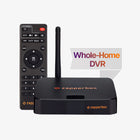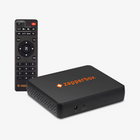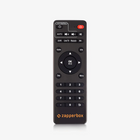ZapperBox requires a minimum drive size of 128GB for DVR. HD and 4K recordings require about 5GB/hour and 1080p recordings require about 2.2GB/hour. This means that a 1TB drive can store 200 hours of HD or 4K video and about 450 hours of 1080p video.
All hard disk drives (HDDs) and solid sate drives (SSDs) that we have tested work with ZapperBox primarily because we use Android. However, The M1 has one USB 3.0 port that provides us to 4.5 watts and one USB 2.0 port that provides up to 2.5 watts. The m2 has one USB 2.0 port. Many hard drives and SSDs are designed to require a peak power close or equal to this maximum and will not work unless you use an external power hub.
As a rule of thumb we have found that most HDDs do NOT work without external power and most SSDs do work without external power. We have tested a few different USB powered hubs and they all work fine. Here is one that is Amazon’s Choice.
microSD cards and cheap thumb drives have a “burnout” problem unless the 60-minute pause buffer is disabled. We have not experienced such problems with SSD (solid state drives) yet. Read about it in this blog post. If you use a microSD card or a thumb drive please ensure that its read speed is rated at 150 MBytes/second or higher. We have found two Flash Thumb Drives (marked with * below) with read speeds rates at 400 MBytes/second that seem to support the continuous pause buffer even after 6 months of testing.
Seagate 1TB HDD (requires external power): https://amzn.to/4nQGp3e
Seagate 4TB HDD (requires external power): https://amzn.to/4ozJ6Y3
Seagate 8TB HDD: https://amzn.to/47SEF3z
Seagate 14TB HDD: https://amzn.to/4qXR5je
SanDisk 512GB Thumb Drive*: https://amzn.to/49mzR97
SanDisk 1TB Thumb Drive*: https://amzn.to/47VGsVA
Western Digital 1TB SSD: https://amzn.to/47YuZEF
SanDisk 2TB Portable SSD: https://amzn.to/47B0tSo
SanDisk 1TB Ultra microSD card: https://amzn.to/4p7mKwP
SanDisk 512GB Ultra microSD card: https://amzn.to/4829RO2
SanDisk 256GB Ultra microSD card: https://amzn.to/4nYdWIX
Samsung Endurance Pro 256GB: https://amzn.to/4oCbCrZ
Amazon basics 128GB microSD card: https://amzn.to/4oCedlJ




